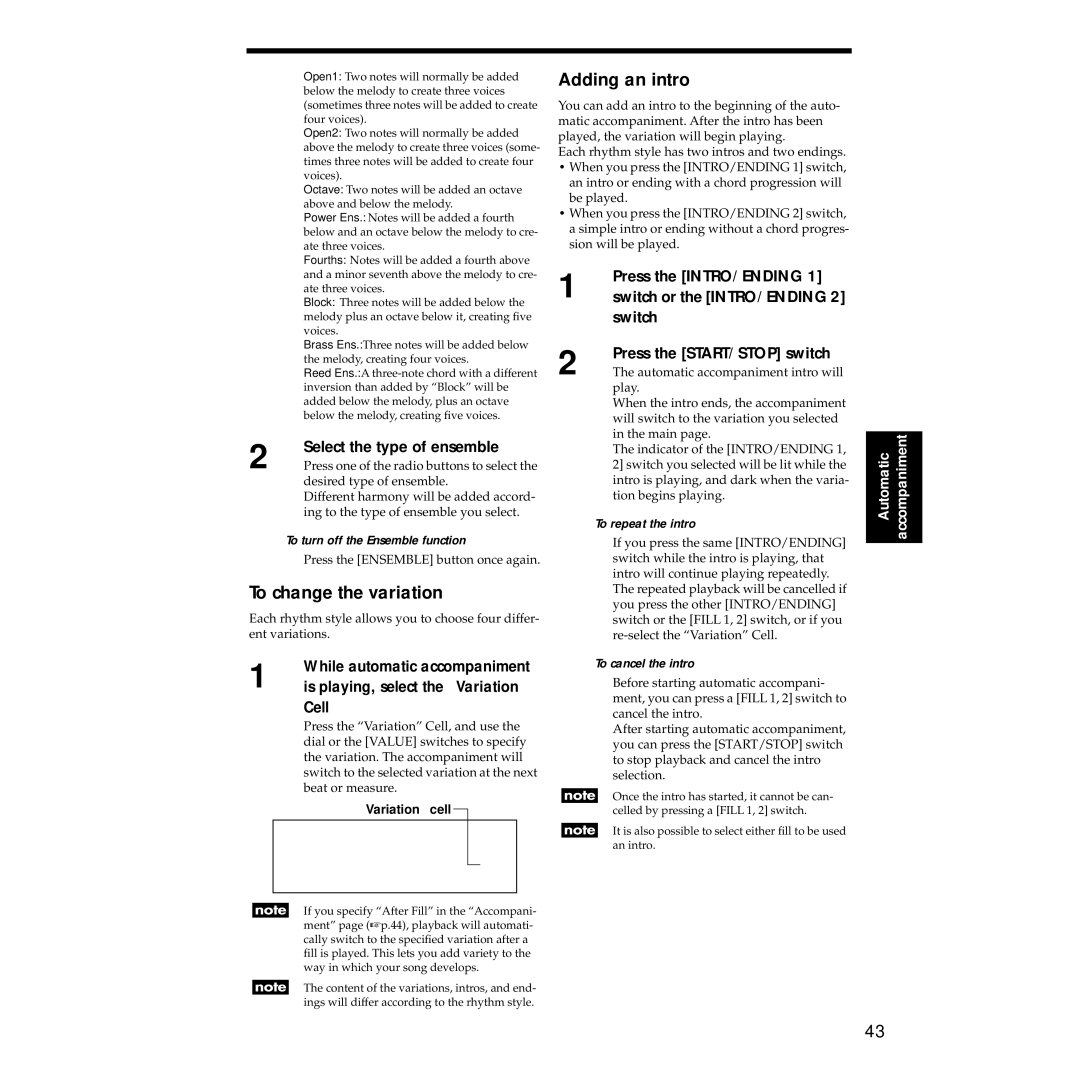
| Open1: Two notes will normally be added |
| below the melody to create three voices |
| (sometimes three notes will be added to create |
| four voices). |
| Open2: Two notes will normally be added |
| above the melody to create three voices (some- |
| times three notes will be added to create four |
| voices). |
| Octave: Two notes will be added an octave |
| above and below the melody. |
| Power Ens.: Notes will be added a fourth |
| below and an octave below the melody to cre- |
| ate three voices. |
| Fourths: Notes will be added a fourth above |
| and a minor seventh above the melody to cre- |
| ate three voices. |
| Block: Three notes will be added below the |
| melody plus an octave below it, creating five |
| voices. |
| Brass Ens.: Three notes will be added below |
| the melody, creating four voices. |
| Reed Ens.: A |
| inversion than added by “Block” will be |
| added below the melody, plus an octave |
| below the melody, creating five voices. |
2 | Select the type of ensemble |
Press one of the radio buttons to select the |
desired type of ensemble.
Different harmony will be added accord- ing to the type of ensemble you select.
To turn off the Ensemble function
Press the [ENSEMBLE] button once again.
To change the variation
Each rhythm style allows you to choose four differ- ent variations.
1 | While automatic accompaniment |
is playing, select the “Variation” |
Cell
Press the “Variation” Cell, and use the dial or the [VALUE] switches to specify the variation. The accompaniment will switch to the selected variation at the next beat or measure.
“Variation” cell
If you specify “After Fill” in the “Accompani- ment” page (☞ p.44), playback will automati- cally switch to the specified variation after a fill is played. This lets you add variety to the way in which your song develops.
The content of the variations, intros, and end- ings will differ according to the rhythm style.
Adding an intro
You can add an intro to the beginning of the auto- matic accompaniment. After the intro has been played, the variation will begin playing.
Each rhythm style has two intros and two endings.
•When you press the [INTRO/ENDING 1] switch, an intro or ending with a chord progression will be played.
•When you press the [INTRO/ENDING 2] switch, a simple intro or ending without a chord progres- sion will be played.
1 | Press the [INTRO/ENDING 1] |
switch or the [INTRO/ENDING 2] | |
| switch |
2 | Press the [START/STOP] switch |
The automatic accompaniment intro will |
play.
When the intro ends, the accompaniment will switch to the variation you selected in the main page.
The indicator of the [INTRO/ENDING 1, 2] switch you selected will be lit while the intro is playing, and dark when the varia- tion begins playing.
To repeat the intro
If you press the same [INTRO/ENDING] switch while the intro is playing, that intro will continue playing repeatedly. The repeated playback will be cancelled if you press the other [INTRO/ENDING] switch or the [FILL 1, 2] switch, or if you
To cancel the intro
Before starting automatic accompani- ment, you can press a [FILL 1, 2] switch to cancel the intro.
After starting automatic accompaniment, you can press the [START/STOP] switch to stop playback and cancel the intro selection.
Once the intro has started, it cannot be can- celled by pressing a [FILL 1, 2] switch.
It is also possible to select either fill to be used an intro.
Automatic | accompaniment |
43
